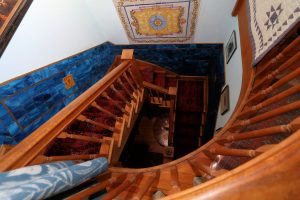Mosaic Design – Preservation Cafe
Posted on October 1st, 2022
“Building with Mosaics ” with Jim Miller, presented Tuesday, October 4, 2022, was recorded and is available for viewing. Jim Miller, a Capitol Hill artist, historian, and renovator, shared the story of his lifelong fascination with mosaics, a journey that would incorporate his passion for history, art, Italy, and his lovely muse Fynnette Eaton. He has used his craft to transform his Capitol Hill home into an elaborate oasis of mosaic design. Fynnette and Jim opened their home for the 2019 CHRS House and Garden Tour – and it can still be viewed on the virtual 2020 StayAtHome House Tour.
Miller had three goals in mind when he first attempted to replicate the mosaic work he so admired during his trips to the Mediterranean – he was fascinated with the historical aspects of mosaic design, he welcomed the physical and immersive aspects of his work which would help him cope with the recent loss of his parents, and he appreciated the fact that this artistic endeavor would help him decorate his new house on Capitol Hill. Jim’s mosaics would serve as a stunning tribute to the time he and his wife Fynnette spent studying in Ravenna and Venice, Italy.
Miller used stone to create his first mosaics – his elaborate patterns created a stunning foyer and decorative kitchen floor. He soon graduated to incorporating broken pottery and ceramics into an artwork that lines his basement stairwell. It was inspired by his favorite artists, Antoni Gaudi, the Catalan architect, and Gustav Klimt, the Austrian painter.
The glass shards Miller began incorporating into his mosaics soon became his primary artistic medium. He appreciates the colorful beauty and malleability glass offers – it allows him to form curved edges that resemble painted works of art. Glass offers thousands of colorful hues and gradations compared to stone which only has about 60 colors. Miller began creating beautiful, intricate, and colorful ceilings to replicate the elaborate Byzantine mosaics he studied while in Europe.
Miller said the Greeks were the first to use mosaics to decorate their stonework and buildings with designs they formed out of pebbles held together with mastic. You can find examples of their work in many parts of Macedonia.
The Etrucians adopted many of the techniques the Greeks had perfected, and the Romans later followed suit. It is no coincidence that we find many long-lasting stone mosaics built into the floors, walkways, and buildings in the ancient ruins located in the countries Rome conquered.
While the use of mosaic designs declined with the collapse of the Roman empire, the artisans of Ravenna, Italy preserved this artistic craft – the city would become home to many of the world’s finest and most beautiful mosaics during the 4th century.
Two thousand years later, the painter Gustav Klimt would spend a lot of time in Ravena and model his paintings on their colorful and soulful religious beauty.
The Byzantines revived the artistic craft of mosaics. They incorporated colorful glass and gold materials into their designs to create ornate mosaics that often had religious themes. Miller said that the island of Torcello which is just north of Venice displays many of the best examples of this spectacular artwork.
The church of Santa Maria Assunta has many excellent mosaics throughout. Mosaics were no longer used to simply decorate the floors – they adorned the walls and ceilings and featured spectacular colors, intricate designs, and figures built with glass and gold.
Miller included photographs of his many mosaic creations in his slides. They include several portraits of his beautiful wife Fynnette, a starburst ceiling, an arabesque chair, an art nouveau clock based on a Gaudi window, chairs with elaborate Klimt themed designs, and painted tiles that feature a welcoming Portuguese lady.
Our CHRS Preservation Cafes are free to CHRS members and non members. Please consider joining CHRS!







